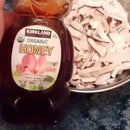Introduction: Wood Pocket Knife Handle
Well, guys, I went to Walmart and bought the cheapest Ozark trail pocket knife there. Now I'll show you how I replaced the cheap plastic handle scales with a juniper wood handle inlaid with strips of juniper bark.
Materials.
-Cheap knife
-torx bit set
-A chunk of wood. (I used juniper)
-saw
-knife
-Dreme (Or a rasp and file)
- super glue and/or epoxy
-sandpaper
-patience
You may be able to do without some of these things if you have more time and patience, I am just telling you what I used.
Step 1: Go Buy a Cheap Knife
Okay guys, seriously this was a $5 dollar knife from Walmart. Ozark Trail brand. Also, all of the screws take a torx head, so make sure you get a cheap torx head set.
Now take apart your knife, you will need all the pieces except the green plastic handle scales.
Step 2: Draw, Shape, Cry.
Now go find a chunk of wood. I used a juniper log I had in my house, but you can use whatever. I just split the wood and flattened it then I drew the lines from one of the metal sides of the knife.
After you have the outline, just use your Dremel or a rasp or file to remove material to the drawn line.
Step 3: Shaping the Handle Scales.
Shape Shape Shape. glue both sides of the wood to one piece of the metal guide and start rounding the edges to you get a comfortable grip. This takes a while without a Dremel but that's fine.
Test it in your hand to see if you like the feel. Don't take too much off because we will still be putting an inlay in.
Step 4: This Part Is a Little Hard.
Honestly, this was the hardest part. Putting the knife back together again. I drilled holes to match the shape of the plastic handles that came with the knife but they were a little bit off so take your time and make it fit all together.
I did end up fitting everything back together nicely and the knife was smooth on the fold. It didn't take too long, it was just frustrating.
By the way, I used Walmarts cheapest 5-minute epoxy to help with the strength of the finished handles.
Step 5: Inlay.
Okay, guys, This will take a long time, but will also be the most fulfilling part of it all. If you like what you have, then you can leave out this step and finish your handles, but I will be telling you what I did
Sorry, I didn't get many pictures here so here are the steps.
-use a file to make little grooves in the handle
-I used strips of bark from the log of juniper but you can use a veneer or a powdered stone or whatever you want to inlay
-Place the bark or other inlay material into the groove and drip super glue over the top. Repeat these layers until you are flush with the top of the wood.
-Now repeat until you have the desired design or number of inlays you would like.
Above you can see the design I was working from but I actually changed it later.
Again, the theory behind this is that the super glue binds the inlay to the wood and also fills the gaps so when you go and sand you get a smooth finish.
Step 6: Sand and Finish.
Some of the inlay was raised above the wood a bit so I used my Dremel to nock it down, then I sanded from 220 grit to 1500 grit to get a perfectly smooth finish.
Now use some type of hardening finish like lacquer or danish oil. I used Danish Oil. This will harden and meld well with the superglue that is already in the wood so I found this worked well for me.
Well, it's finished. Enjoy it and show all your friends. They will love it.
Hey, this is my first time working with knife scales and/or handles so let me know what I can do next time to make it better.
Comment below thoughts or tips and show us any pictures if you make it or anything similar.
Thanks for reading and go check out all my other Instructables.
Also, go vote for this in the woodworking contest.
Step 7:

Participated in the
Woodworking Contest













